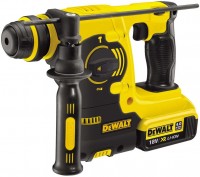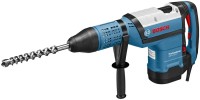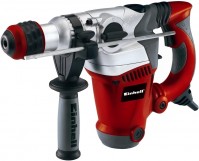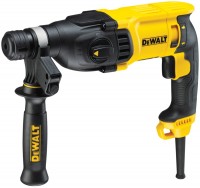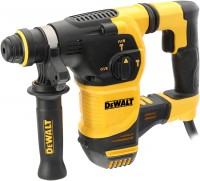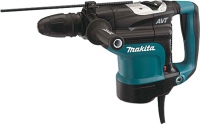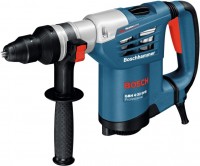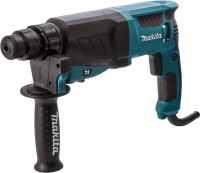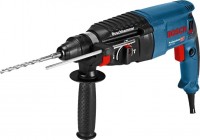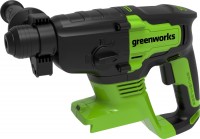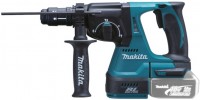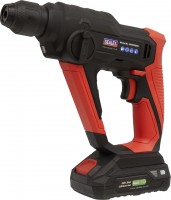Rotary Hammers DeWALT
All Rotary Hammers Advanced filters → |
You might be interested in
Articles, reviews, useful tips
All materials
Drill chuck: types and differences
Specifics of different types of chucks for drilling and working with fasteners

Screwdriver that can drill concrete: myth or reality
What does it take to drill a hole in the wall with a screwdriver? Which model should I choose for drilling concrete?

Screwdrivers and drills for dummies
Questions about drills and screwdrivers that beginners are embarrassed to ask more experienced craftsmen

One battery for the whole tool: multi-platform battery series
The concept of using a universal battery for cordless tools is gaining momentum

Sparks, smoke, crunch and burning smell: what can break in a drill or screwdriver
We understand why drills and screwdrivers smoke, spew sparks, overheat, make strange sounds and work poorly

Noise levels of tools and construction equipment
The concepts of sound power and sound pressure, as well as the differences between them in fact
Rotary Hammers: specifications, types
Show all
Operating modes
— Drilling with impact. A mode of operation that combines rotation and percussive movement of the drill. Due to this, a complex effect on the treated surface is provided; in this case, the impact gives a direct advancement of the drill, and rotation is used primarily to remove the resulting waste. It is this format of work that allows you to effectively make holes in materials like concrete, brick, natural stone, etc .; at the same time, rotary hammers cope with such tasks much more efficiently...than the so-called impact drills (drills supplemented with a chiseling function).
— Drilling (without impact). Traditional drilling, when the hammer works like a drill: the working equipment only rotates, not moving back and forth. It is applied to work with rather soft materials, such as a tree and metal. At the same time, rotary hammers are often more efficient than traditional drills — due to the greater power and weight of the tool, they allow you to drill larger and deeper holes with sufficient accuracy.
— Chiseling (demolition hammer). In this mode, the punch tool only moves back and forth, without rotation. This format of work can be useful when splitting large pieces of hard material, removing various coatings, etc. We emphasize that a rotary hammer, even a powerful and heavy one, will not replace a full-fledged demolition hammer; however, for relatively simple tasks — such as dismantling small structures made of relatively soft materials, splitting tiles, chasing walls, etc. — a tool with this mode is quite suitable.
— Drilling (without impact). Traditional drilling, when the hammer works like a drill: the working equipment only rotates, not moving back and forth. It is applied to work with rather soft materials, such as a tree and metal. At the same time, rotary hammers are often more efficient than traditional drills — due to the greater power and weight of the tool, they allow you to drill larger and deeper holes with sufficient accuracy.
— Chiseling (demolition hammer). In this mode, the punch tool only moves back and forth, without rotation. This format of work can be useful when splitting large pieces of hard material, removing various coatings, etc. We emphasize that a rotary hammer, even a powerful and heavy one, will not replace a full-fledged demolition hammer; however, for relatively simple tasks — such as dismantling small structures made of relatively soft materials, splitting tiles, chasing walls, etc. — a tool with this mode is quite suitable.
Real power
The power given out by the perforator directly to the drill or other working equipment. This figure is inevitably lower than the power consumption (see below) due to energy losses in the tool mechanisms.
In general, higher net power means more efficiency and productivity; the reverse side of these advantages is an increase in price, energy consumption, dimensions and weight (however, the latter is not always a drawback for rotary hammers). In addition, note that tools with similar usef...ul power values may differ in the ratio of chiseling speed and impact power: remember, a higher frequency means less energy for each individual impact, and vice versa. So the big numbers in this paragraph can mean both high efficiency when working with hard, stubborn materials, and good performance on relatively simple tasks; these features need to be specified separately.
Also, by the ratio of useful and consumed power, one can evaluate the efficiency of the tool in terms of energy consumption: the lower the power consumption (with the same useful power), the more efficient this model is. The downside of energy efficiency is often increased cost, but it can be recouped fairly quickly in energy savings, especially if you work long hours and often.
In general, higher net power means more efficiency and productivity; the reverse side of these advantages is an increase in price, energy consumption, dimensions and weight (however, the latter is not always a drawback for rotary hammers). In addition, note that tools with similar usef...ul power values may differ in the ratio of chiseling speed and impact power: remember, a higher frequency means less energy for each individual impact, and vice versa. So the big numbers in this paragraph can mean both high efficiency when working with hard, stubborn materials, and good performance on relatively simple tasks; these features need to be specified separately.
Also, by the ratio of useful and consumed power, one can evaluate the efficiency of the tool in terms of energy consumption: the lower the power consumption (with the same useful power), the more efficient this model is. The downside of energy efficiency is often increased cost, but it can be recouped fairly quickly in energy savings, especially if you work long hours and often.
Power consumption
Rated power consumed by the rotary hammer during operation. Usually, the maximum power consumption in normal operation is taken as the nominal power.
In general, the higher this indicator, the heavier and more performant the rotary hammer is, the more advanced its performance usually turns out to be. On the other hand, the electricity consumption of such tools is high. In addition, note that with the same power consumption, the actual set of individual characteristics for different too...ls may be different. For example, frequency and impact energy are inversely related, and for the same power input, higher frequency usually means less individual impact energy. So, according to this parameter, it is worth evaluating only the overall level of the instrument; for accurate selection for specific tasks, you need to pay attention to more specific characteristics.
Also note that power consumption data can be useful for some tasks related to catering — for example, if a construction site is powered by an autonomous generator and you need to estimate the load on this energy source.
In general, the higher this indicator, the heavier and more performant the rotary hammer is, the more advanced its performance usually turns out to be. On the other hand, the electricity consumption of such tools is high. In addition, note that with the same power consumption, the actual set of individual characteristics for different too...ls may be different. For example, frequency and impact energy are inversely related, and for the same power input, higher frequency usually means less individual impact energy. So, according to this parameter, it is worth evaluating only the overall level of the instrument; for accurate selection for specific tasks, you need to pay attention to more specific characteristics.
Also note that power consumption data can be useful for some tasks related to catering — for example, if a construction site is powered by an autonomous generator and you need to estimate the load on this energy source.
Impact energy
The energy transmitted by the perforator to the material being processed upon impact; the higher this indicator, the stronger and more powerful each individual blow.
First of all, we recall that the energy of impacts is directly related to their frequency: an increase in frequency leads to a decrease in energy. Therefore, for models where the number of strokes can be adjusted, this paragraph usually gives the maximum energy achieved at the minimum speed of operation.
In gener...al, higher impact energy improves efficiency when working with hard, stubborn materials, but requires more motor power (especially if it has to be combined with a high frequency). Therefore, it is worth choosing according to this parameter, taking into account specific tasks. So, for occasional use in everyday life, an energy of 2 J or less is enough, for home repair work of medium intensity, at least 3 J is desirable; a power of 4 J or more is already considered high; and in some industrial-grade perforators, this figure can reach 30 J.
First of all, we recall that the energy of impacts is directly related to their frequency: an increase in frequency leads to a decrease in energy. Therefore, for models where the number of strokes can be adjusted, this paragraph usually gives the maximum energy achieved at the minimum speed of operation.
In gener...al, higher impact energy improves efficiency when working with hard, stubborn materials, but requires more motor power (especially if it has to be combined with a high frequency). Therefore, it is worth choosing according to this parameter, taking into account specific tasks. So, for occasional use in everyday life, an energy of 2 J or less is enough, for home repair work of medium intensity, at least 3 J is desirable; a power of 4 J or more is already considered high; and in some industrial-grade perforators, this figure can reach 30 J.
Number of thrusts
The number of beats per minute provided by the punch. For models in which the beat frequency can be adjusted, this item indicates the entire adjustment range, for example "1600 — 3000".
High impact frequency, on the one hand, increases the productivity of the tool and can significantly reduce the time required for work. On the other hand, with the same engine power, an increase in the number of strokes per minute leads to a decrease in the energy of each stroke. Therefore, among heavy...performant devices, a low frequency is often found — up to 2500 beats / min and even lower. And the ability to adjust the frequency of impacts allows you to adjust the hammer to the specific situation, depending on what is more important — productivity or the ability to cope with hard, stubborn material. For example, for old crumbling brickwork, you can set the speed higher, and for working with stone or dense concrete, it is better to reduce the frequency of impacts by directing engine power to increase the energy of each impact.
Summing up, we can say this: when choosing a perforator, you should focus on both the number of strokes and the impact energy. Detailed recommendations on this subject for specific situations can be found in special sources.
High impact frequency, on the one hand, increases the productivity of the tool and can significantly reduce the time required for work. On the other hand, with the same engine power, an increase in the number of strokes per minute leads to a decrease in the energy of each stroke. Therefore, among heavy...performant devices, a low frequency is often found — up to 2500 beats / min and even lower. And the ability to adjust the frequency of impacts allows you to adjust the hammer to the specific situation, depending on what is more important — productivity or the ability to cope with hard, stubborn material. For example, for old crumbling brickwork, you can set the speed higher, and for working with stone or dense concrete, it is better to reduce the frequency of impacts by directing engine power to increase the energy of each impact.
Summing up, we can say this: when choosing a perforator, you should focus on both the number of strokes and the impact energy. Detailed recommendations on this subject for specific situations can be found in special sources.
Rotation speed
The speed of rotation of the working equipment provided by the rotary hammer. Usually, this indicates the speed at idle, without load; rated load speeds can be further specified in the characteristics (see below), but this is rare, and this parameter is still considered the main characteristic. It is also worth mentioning that in the presence of a speed controller (see "Functions"), the maximum speed value is given here.
When working in the main mode — drilling with impact — the rotati...on of the equipment is used mainly to remove waste from the hole, and the revolutions here are of no fundamental importance (they can be very low). Therefore, it is worth paying attention to this indicator mainly in cases where the rotary hammer is planned to be often used for conventional drilling, without impact. And here it is worth proceeding from the fact that high speeds increase productivity and contribute to accuracy when working with some materials, but reduce torque (compared to tools with the same engine power). So for heavy work with hard, stubborn materials, relatively "slow" tools are usually better suited.
Note also that drilling is not the main task of rotary hammers; therefore, their rotation speeds are noticeably lower than those of the same drills. On the other hand, in this case, low speeds are often compensated by powerful engines and high torque, which makes it possible to effectively drill holes of a fairly large diameter, including using crowns.
When working in the main mode — drilling with impact — the rotati...on of the equipment is used mainly to remove waste from the hole, and the revolutions here are of no fundamental importance (they can be very low). Therefore, it is worth paying attention to this indicator mainly in cases where the rotary hammer is planned to be often used for conventional drilling, without impact. And here it is worth proceeding from the fact that high speeds increase productivity and contribute to accuracy when working with some materials, but reduce torque (compared to tools with the same engine power). So for heavy work with hard, stubborn materials, relatively "slow" tools are usually better suited.
Note also that drilling is not the main task of rotary hammers; therefore, their rotation speeds are noticeably lower than those of the same drills. On the other hand, in this case, low speeds are often compensated by powerful engines and high torque, which makes it possible to effectively drill holes of a fairly large diameter, including using crowns.


